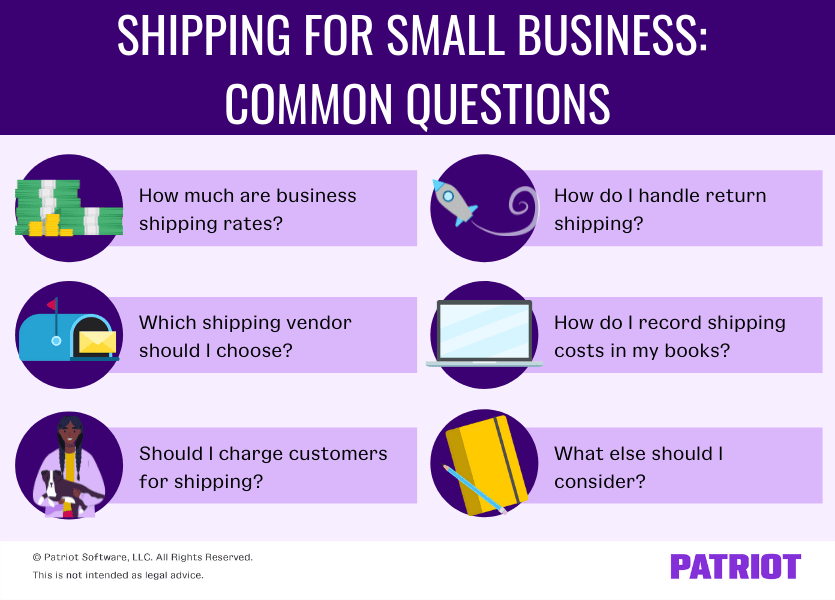So, you’re going to ship out your products, eh? With over two billion online shoppers worldwide in 2021, it’s easy to see why. But before you can start shipping for small business, you must make some decisions, like packaging, the shipping vendor, and speed. After all, you don’t want shipping for business to shrink your profits.
Ready to get the ball rolling on shipping for small business? Read on for a how-to question and answer guide.
Shipping for small business: A Q&A how-to guide
If you want to get started with shipping for business, you probably have questions you need answered, like:
- How much are business shipping rates?
- Which shipping vendor should I choose?
- Should I charge customers for shipping?
- How do I handle return shipping?
- How do I record shipping costs in my books?
- What else should I consider?

1. How much are business shipping rates?
Again, cost is probably the first thing you want to know about shipping. Once you know how much shipping services will cost, you can figure out your budget, pricing, and profit margin.
So, what are the average business shipping rates? According to Bradley Katz, co-founder and CEO of Axon Optics:
Business shipping rates can vary widely depending on package size, weight, delivery speed, and location. On average, a small package can cost about $8, while large packages can cost about $18 to $21 for shipping.”
To determine what your individual business shipping rates may be, answer questions such as:
- Speed: Are you expediting shipping to get the package to your customer quicker?
- Product specifics: How much does the package weigh? What are the dimensions?
- Destination: What is the distance between your address and the customer’s?
- Shipping volume: How much and how often are you shipping? Are you eligible for discounts?
- Vendor: What shipping carrier are you using?
2. Which shipping vendor should I choose?
One of the first decisions you need to make is what shipping vendor you’ll use to deliver your products to customers.
The most common shipping companies for small businesses include:
Each shipping carrier has different programs that come with special features, like reward systems, business discounts, and easy returns. Talk with prospective shipping vendors to find the best shipping for small business (e.g., shipping rates, insurance policies, speed, etc.).
3. Should I charge customers for shipping?
Once you know how much shipping your products costs, you can determine whether you want to foot the bill or not. And if you do decide to involve customers, you have some questions to answer.
You must decide if you’ll:
- Charge customers for part or all of your shipping costs.
- Provide free shipping if customers spend over a certain amount.
- Raise product prices to offer free shipping to customers.
- Offer expedited shipping options customers are responsible for.
Whatever you decide, clearly list your shipping rules on your business website before and at the point of sale. For example, you might say something like “Free shipping on orders over $50!” on your website.
4. How do I handle return shipping?
Whether you’re selling from your brick-and-mortar or shipping products, sales returns happen. Answer questions like:
- Who pays for return shipping?
- How long do customers have to return an item?
- Where do customers need to go to ship items back to you?
List your return policy clearly on your website. Consider dedicating an FAQ section to returns so customers don’t have to reach out to you with basic questions.
5. How do I record shipping costs in my books?
When you cover shipping costs, you incur a business expense. So, you need to record shipping costs in your accounting books.
A shipping cost is an expense known as “freight out.” Freight out is a type of cost of goods sold (COGS) expense, not an operating expense. So, record shipping costs under the COGS section on your income statement.
Expenses are increased by debits and decreased by credits. You must debit a shipping-related expense account (e.g., Delivery Expense) and credit an account you pay from (e.g., Cash).
Take a look at this example of how you might record a shipping cost in your books:
| Date | Account | Debit | Credit |
|---|---|---|---|
| X/XX/XXXX | Delivery Expense | X | |
| Cash | X |
Now, let’s say you incur a freight expense but don’t pay it yet. Instead of crediting your Cash account, you would credit your Accounts Payable account. This shows that you’ve incurred the cost but have not yet paid it.
For example, accounting for shipping (without paying yet) would look like this:
| Date | Account | Debit | Credit |
|---|---|---|---|
| X/XX/XXXX | Delivery Expense | X | |
| Accounts Payable | X |
6. What else should I consider?
You may have additional shipping-related costs you must account for in your budget. Before weighing your shipping options for small business, also consider the following:
- Branded packaging
- Chargeback fraud
- Extra insurance
Branded packaging
Do you want your packaging to reflect your brand? If so, consider the cost of branded packaging, including:
- Boxes
- Tissue paper
- Shipping labels
- Packing slips
Customizing your packaging could increase brand awareness and set your business apart from others.
Chargeback fraud
Unfortunately, shipping to customers can open the door for chargeback fraud. Chargeback fraud is when a customer receives a product but says they never got it.
If you experience chargeback fraud, you can expect inventory shrinkage and decreased profits. To help fight fraud, make sure you receive shipping verification from your shipping partner (e.g., a photo of the product on the customer’s porch).
Extra insurance
Insurance covers expenses related to product loss or damage. Although many carriers automatically offer a certain level of insurance (e.g., up to $50 of coverage), you might opt for more.
For extra product protection, consider getting additional coverage through your carrier (if applicable) or a third party. Third-party insurance typically charges a fee per amount of product value (e.g., $0.80 fee per $100 value). You may also need to pay a minimum cost for insurance.
This is not intended as legal advice; for more information, please click here.



